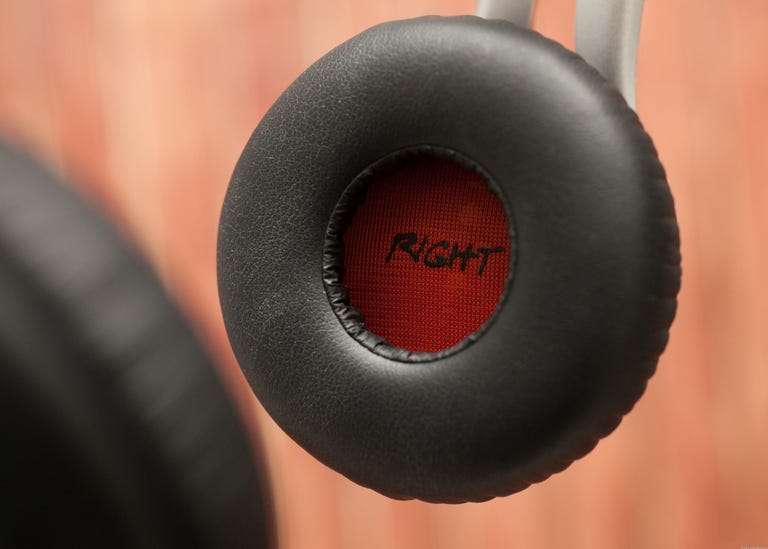 Why You Can Trust CNET
Why You Can Trust CNET Jabra Revo headphones review: Superior design meets strong sound
One of the better on-ear headphones, the Jabra Revo combines strong sound quality with superior comfort and design.
Jabra is best known for its wired and wireless headsets, but it's now ventured into the premium headphone market with two on-ear models, the Revo ($200 list) and
The Good
The Bad
The Bottom Line
Both the Revo and Revo Wireless have very similar designs and they're among the more comfortable and well-designed on-ear headphones I've tested, with a sturdy fit and finish and a folding design. I liked both models a lot, but the "wired" Revo reviewed here offers better sound quality and is arguably the better overall value, with a "street" price of around $150.
Design and features
Like the Revo Wireless, the Revo is well designed and has a sleek look (the headphones come in dark gray and white). When it comes to on-ear headphones, I'm usually very picky -- I prefer over-the-ear or in-ear models -- but I had no problem with these. They have memory foam in their earpads, and they conform to your ears nicely and seal out a good amount of ambient sound. It's also worth noting that they don't fit so tight as to pinch down on your ears, so they offer a secure fit -- but not too secure.
The headphones feel sturdy and have a nicely air-cushioned headband, with metal armatures. I also appreciated that the earcups are labeled "right" and "left" on their interiors, so it's easy to figure out which is which.
As noted, the headphones fold up. And while they don't turn into a supercompact package, it's fairly compact.
I can't say that I was impressed with the carrying bag that comes with the product. It's thin, lightweight, and very basic. At this price, I'd expect something a little more luxurious. The
Like many premium headphones today, the Revos come with a detachable cable. It has an integrated remote and microphone for cell phone calls and it's cloth-covered, which makes it tangle-resistant. However, that cloth covering can make a sound if it rubs against your clothing (I didn't have a problem with it, but some people hate it when they can hear the cord rubbing up against something while they're listening to their music).
It's also worth mentioning that the Revos have two headphones jacks, one at the base of each earcup. The extra jack allows another person to plug his or her headphones into the open jack and listen to whatever you're listening to.
And finally, the cord terminates in an L-shaped plug. Such plugs tend to be more durable than straight plugs, but if you have a thick, tough case on your smartphone, the plug may not fit into the headphone jack.
Performance
When I reviewed the wireless version of these headphones, I said that it was hard to rate the performance because they sounded comparatively decent for Bluetooth headphones, but not nearly as good as wired $250 headphones should sound.
The sound quality of the wired Revos reviewed here is easier to judge: it's very good. Overall, the sound is clean and dynamic, with plump but not overwhelming bass and fairly crisp highs. I can't say the sound is quite up to the level of the larger, over-the-ear
It's worth noting that you can choose to run your music through Jabra's Sound app, which is available as a free download for iOS and Android devices with an included code. The app allows you to tweak the bass and treble and gives you the option of turning on Dolby Digital Plus processing, which changes how your music sounds. Some will think that the Dolby processing improves the sound and others might not think it really makes it better. You also have the option of activating a "Mobile Surround" mode, which gives the impression of a widened sound stage.
Audio purists probably won't like any of this stuff, but, as I said, some folks will prefer the Dolby processing. Regardless, the app works only with your iTunes library on your phone (or music library on your Android phone) and not with music services like Spotify and Rdio, which more and more people -- including me -- are using.
Other headphones in this price class include the aforementioned Bose OE2i, which is a lighter, slightly more comfortable headphone, that folds into a more compact form factor. The Bose has a bit smoother, creamier sound (it's a little less dynamic). You'll also find plenty of other on-ear models between $150 and $200 (and less), including the well-crafted
While the Revo isn't distinctly better than the P3 and other top competitors, it holds its own against them, and in many cases, is the more comfortable choice.
It's also worth mentioning that used as a headset, the Revo works quite well. Callers said they could hear me fine and that my voice sounded clear (at least indoors without any wind blowing).
Conclusion
Generally, the two most important factors in headphones are comfort and sound quality. You can argue over which is more important, but I don't give an "excellent" rating to a headphone unless it's very strong in both categories.
Putting aside the fact that Jabra could have thrown in a better carrying pouch at this price, I thought the Revos delivered on both the comfort and sound-quality front, and they're about $100 more affordable than their wireless counterparts, the Revo Wireless. Mobile users will also appreciate the inclusion of an inline remote/microphone.
As I said earlier, I may not be a huge fan of on-ear models, but I'm a fan of the Jabra Revo. While it may not be a bargain at around $160, it's a very solid headphone, particularly for mobile users looking for a model that's sturdy yet not too bulky.


